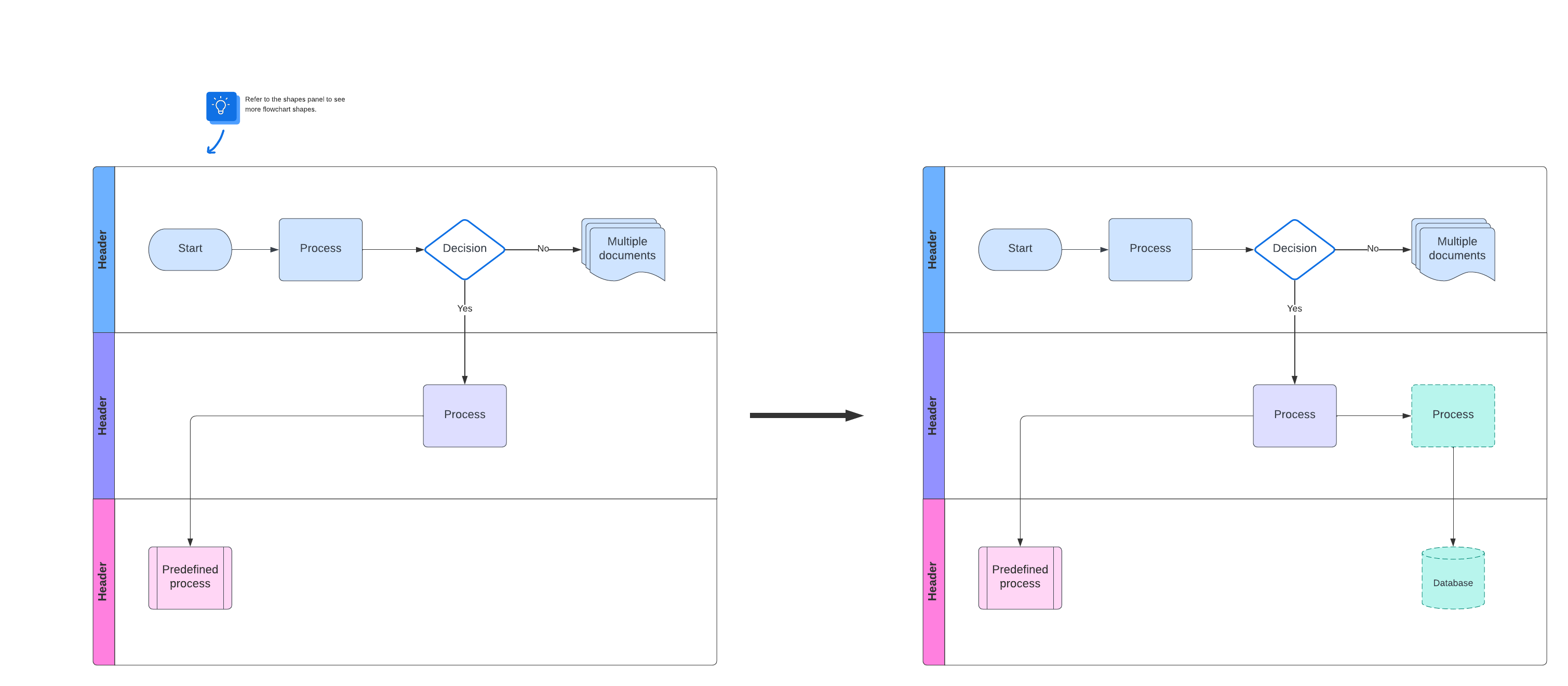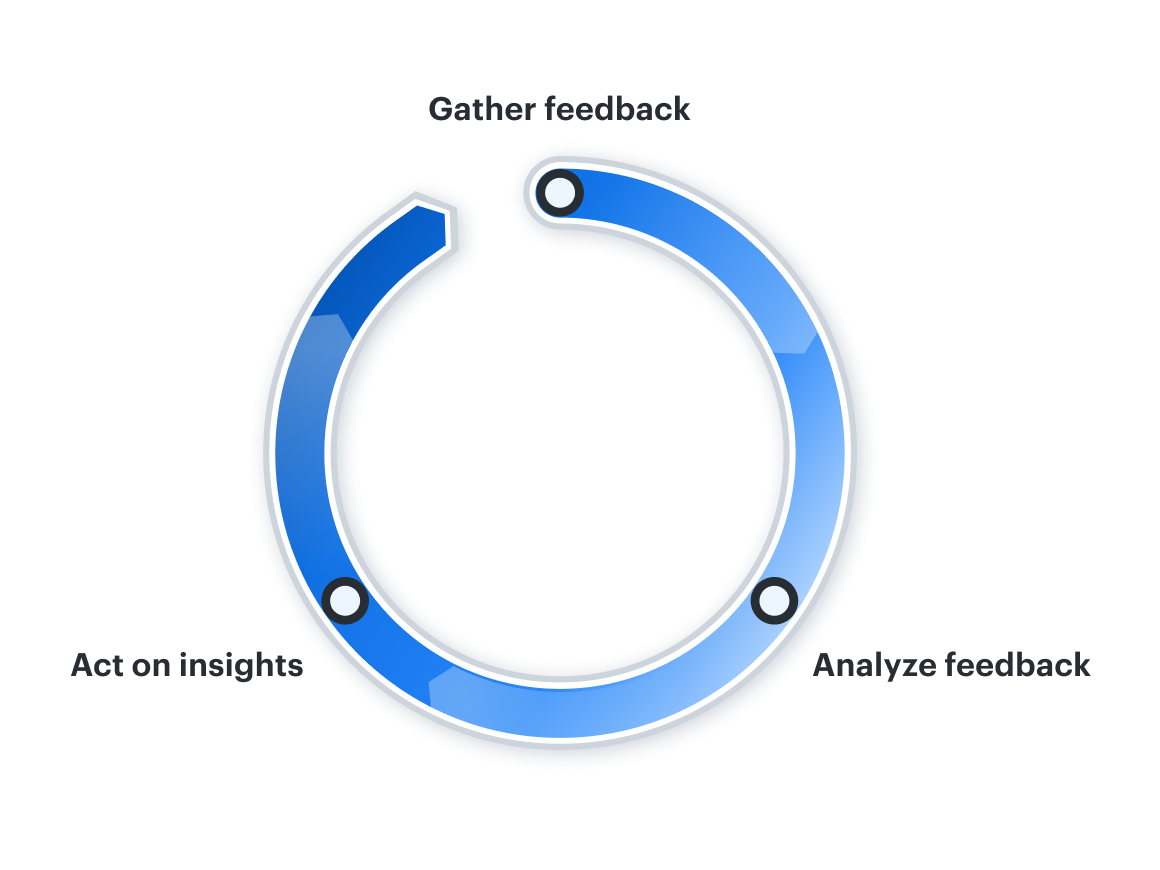
5 organizational change management strategies for a modern workforce
Reading time: about 13 min
Topics:
Benjamin Franklin once said, “When you’re finished changing, you’re finished.”
This mantra might be more relevant now than ever before. We’re living in the fastest-changing work landscape in history. Organizations must pivot frequently to accommodate technological and cultural shifts, including changing work conditions, an uncertain economy, return-to-office mandates, AI advancements, and more. If they don’t, they’ll get buried by the competition.
But implementing a new change isn’t always straightforward. In 2023, 77% of HR leaders said organizational changes burned out their people. How can you guide your team through change fatigue to pull off an org-wide shift?
To answer this question, we sat down with Jeff Rosenbaugh and Christopher Bailey from Lucid’s professional services team, who have a combined 30+ years of industry experience in rolling out enterprise software, organizational culture change, and Agile transformation. They shared that expertise with us so we could find out how to lead organizational change management effectively in a workforce that’s burnt out on change.
A word on change management models
Change management models aren’t a one-size-fits-all solution. So, instead of recommending a specific one for you to follow, we’re sharing expert tips and leading practices that are universally applicable.
Before diving in, here are the most common change management models for reference. The tips shared in this article are relevant (and essential) to all of them.
- Kotter's eight-step change model: In a few steps, this model uses people’s experience to lessen resistance so they can accept change.
- Lewin's change management model: This model has three steps reflecting the process of melting and reshaping an ice cube.
- ADKAR model: Used to facilitate change at the individual level, this is a people-centric model.
- Kubler-Ross change curve: This popular strategy breaks down how people process change using the five stages of grief.
- McKinsey 7s model: This is a process that’s centered around aligning seven fundamental elements across any organization
- PDCA: This framework features a cyclical, iterative model focused on continuous improvement.
- Satir change model: This people-centered model concentrates on managing people's experience transitioning to change.

7 fundamental change management models
Want to learn more about these frameworks? Check out our article!
Read now5 leading practices for successful change management
These five leading practices come from Lucid’s very own change management experts. Regardless of which framework you follow, these tips will help you combat change fatigue and successfully lead your organization through a transformation.
Let’s dive in.

1. Develop the case for change
Instead of diving into the deep end with a model and relying on it to guide the entire process, start by getting ultra-clear on the story and the vision behind the change.
Rosenbaugh said, “When we start working with a new customer, they often don’t have a comprehensive vision upfront. One of the most impactful things for leaders is to develop their case for change, paint a vivid picture for their teams, and get everyone to rally around it. That’s what makes change compelling.”
What’s the most important thing to remember as you assemble that vision? According to Rosenbaugh: “Appeal to human needs and desires.” Using authority to command change doesn’t inspire action or cultivate trust with your people. Instead, keep the personal impact of the change in mind.
Leaders initiate change because they feel it will positively impact their organization. Effectively relaying that personal impact to your teams is key. Start by asking questions such as:
- How does this change benefit your people?
- How will it improve their workflow, collaboration, or work-life balance?
- What issue does it solve?
- What opportunities does it provide?
- What are the risks if we do nothing?
Make sure to articulate clearly how this change ties into broader business objectives. This clarity will help solidify your case for change by connecting the why to shared goals.
We mentioned earlier that one of the most challenging aspects of change management today is change fatigue. Teams are exhausted. The last thing most people want to hear is that they have to switch to a new platform, change up their workflow, or alter their daily routine further.
Change is often hard to understand, which can be tiring. People might also struggle to distinguish this change from failed ones, leaving them unconfident in the future state and more burnt out.
This is where a clear vision and a why can help.
Let’s look at an example. Say an organization has been using multiple collaboration platforms. Technical teams follow different workflows from non-technical teams. As a result, projects are constantly slipping through the cracks. Leadership decides to move everyone to a new collaboration platform to standardize organizational processes.
You can see where there’s going to be some immediate pushback. For one thing, these teams are comfortable with their current workflows. They’re familiar with their respective platforms and are worried that switching to a new one will just cause them more stress. Certain teams might be skeptical that the new platform will be feature-rich enough for their needs.
So, how can leadership effectively appeal to their organization about this change?
First, they’ll have to answer some of the above questions as they develop their case for change. They decided that the move to this new platform would benefit their people by making sharing and collaboration more seamless, thus reducing friction in their day. It will allow teams to be more agile and innovative. It provides more opportunities for creativity.
And, if they do nothing, they risk falling behind on innovative ideas and losing traction to competitors because they have an ineffective collaboration workflow.
The team makes this vision understandable and easily accessible, ensuring they can walk their organization through these benefits clearly in their next meeting.
2. Visualize the current and future state
Removing systematic impediments is a crucial part of the change process. But how can you identify those blockers and establish proactive actions to remove them?
Creating visuals that show what’s changing (the current state) and how it’s changing (the future state) is essential.

3 ways leaders can use visuals as a catalyst for change
Learn more about using visuals to drive change management in this article.
Check it outVisualizing existing bottlenecks in your current state makes it easy for your team members to see the impact of the future state. It can be difficult to communicate that this new change will remove ten steps from their current workflow—it’s much easier to visualize that information.
“When you can show teams their current workflow and visualize the new process, you can point out the benefits of the change. You might show them that there are fewer steps in the process, or certain things are integrated better,” said Bailey.

Determining your organization’s value streams can be an important part of that process. Visualizing your value streams makes communicating how a new change fits into those streams much easier. Value streams can highlight ways that a new change eliminates waste and improves effectiveness across the organization.

Let’s return to our example of a leadership team attempting to implement a new collaboration platform. They’ve visualized their value streams to communicate how this change will tie into the why—and effectively demonstrate the impact on shared business goals.
One of those value streams includes bringing new product features to the market. In this case, product development teams need to communicate with GTM teams at various stages of the process. Changing to a new collaboration platform will make that communication easier.
They created a visualization of their current state. It shows a divided organization where teams struggle to communicate with each other, and having to duplicate work from one platform to another is just one of the many impediments wasting time and resources.
They also built a powerful future state visualization that shows a united company where collaboration flows easily between all teams. It shows fewer steps between processes, easier sharing workflows, and better cross-functional collaboration. It’s an inspiring visualization; the teams are more on board after seeing the expected improvements.
3. Embrace the feedback loop
We’ve discussed the importance of communicating with your teams, but do they have a way to communicate with you?
Establishing methods of collecting ongoing feedback throughout the adoption process is critical. It will help you identify blockers, gripes, and struggles with the change so you can address them. This communication will ensure teams feel heard and supported throughout the process.

Understanding the feedback loop is also an important part of the above tip because it ties into removing systematic blockers. If your team has effective communication channels to provide feedback on the change, leadership teams can quickly identify and remove blockers to success.
Lucid’s Visual Activities are a great way to collect feedback. Visual Activities function like a visual, interactive poll that you can share broadly with your organization. Team members can provide their input, and you can aggregate those results with the click of a button.
You might use polls like these during company meetings to collect feedback on the spot. You can also send them out via internal communication systems to collect asynchronous feedback on an ongoing basis.

An incredibly beneficial byproduct of this feedback loop is hearing about success stories. The early stories can be especially beneficial, which leads us to our next tip.
4. Share early success stories
It’s the journey, not the destination. Leaders may get discouraged when change management doesn’t go as planned. Sometimes, new adoptions just take time. So celebrate small wins along the way!
Gathering early (and ongoing) success stories is a great place to start. Rosenbaugh and Bailey shared how Lucid’s professional services team makes it a priority to celebrate small successes during an implementation process.
“This is one of the things we strongly believe in,” stated Rosenbaugh. “The small wins cascade and grow into much bigger organizational wins. That philosophy really aligns with our methodology. We try to identify small wins and communicate those on behalf of our customers.”
Bailey discussed the importance of sharing these early success stories with the organization: “A new change is likely going to break workflows that individuals are very used to, and leaders need to help them see the benefit of that. This could be an opportunity for the leader to hear them out and address an unexpected issue that came from the change, solving problems so the team can get to the vision that was laid out previously.”
Let’s return to our example of adopting a new collaboration platform org-wide. When leadership solicits feedback from their teams, they hear of a member of the marketing team who’s found great success with the new platform. This individual is leveraging an automation capability that makes it easy to organize their campaign planning notes and share them with the rest of their cross-functional team.
“Gathering those success stories is key to creating momentum early on,” said Bailey. The leadership team can now make an additional touch point with their organization and share this story, along with any others. Now, their teams have a tangible example of one of their peers sharing about the personal impact of the change.
Pro tip: Try using Lucid as a digital space where people can collect and share wins. With Lucidspark, you could create a shared board with designated areas for team members to highlight their successes and see other people’s use cases. In leadership meetings, you could use emojis to highlight your favorite use cases or vote on the best ones. Then, you can share those favorites in a company update or similar meeting.

Sharing other people’s use cases, specifically, can be beneficial. Some team members may develop exciting ways of working within a new tool or process that inspires others. Rosenbaugh said, “[Sharing use cases] is really helpful because it opens people’s perspectives. When you expose individuals to a new use case, they get that aha moment, and it clicks.”
Returning to our collaboration platform migration example: At this point, the team has prioritized celebrating small wins. After a couple of months of this process, they’re starting to share bigger success stories.
Now, the teams are talking about how much easier the collaboration process is within their functional and cross-functional teams. Team members are sharing how much simpler it is to work with technical and non-technical teams alike. Individuals are saying that their teams can be more agile and innovative.
The organization is starting to feel empowered and better equipped to do their best work.
5. Provide ongoing support
Change management initiatives are complex, especially at an organizational level. Despite this, many leaders underestimate the level of support they’ll need in the process and how much support they should offer their teams.
“Underestimating the amount of support needed usually comes from a lack of a comprehensive vision,” said Rosenbaugh. “For example, new Lucid customers will often be most concerned about migrating their documents over to our platform, but that’s probably 10% or less of the change management process.”
Rosenbaugh talked to us about the 7x7 concept, which means you need at least seven ways of communicating a change across your organization at least seven different times. That might mean discussing the change in several org-wide meetings, such as all-hands, kickoffs, or broadcasts.
Many leaders might be surprised to hear that communicating a change seven times through seven different channels is the minimum. Leaders must communicate what’s going well and what needs improving throughout the process. Repetition is key. Consistently communicate with your team that this change is important and strategic.
Finding ways to standardize processes is one crucial way to make change easier for your teams. Building custom templates for various use cases is a great example of standardizing a process on a new platform, and is something Rosenbaugh and Bailey do for new Lucid customers on the regular. Rosenbaugh said, “These custom Lucid templates are just an example of how we can help standardize certain processes, reduce setup time, and make teams comfortable.”
Rosenbaugh and Bailey’s team creates familiarity and consistency during these transitions by having customers use their company’s branding on these custom internal templates. Little touches go a long way in establishing consistency and building confidence.
To revisit our example of the organization adopting a new collaboration platform: How can their leadership team ensure they provide adequate support?
For one thing, they’ll need to provide training and educational resources and ensure their teams know where to find those resources. The training should be comprehensive. Their leaders should make sure to answer as many questions as possible. The more upfront education everyone receives, the more likely leadership will get quick buy-in and early success stories.
In summary, offer as much support as possible. Change management initiatives require lots of planning, thoughtfulness, and intention to go off without a hitch.
Visualize your change management initiatives with Lucid
Change management on an organizational level is always intensive. After all, you’re dealing with so many moving gears. Everything has to go smoothly. For that to happen, you need a clear understanding of your vision for change and a way to communicate that with your teams in a digestible way.
Lucid has your back. Using the Lucid Visual Collaboration Suite, you can brainstorm, collaborate, diagram, and otherwise visualize your change management process with your organization.
Our team is ready to help streamline the entire process. Lucid’s professional services team comprises best-in-class experts committed to providing tactical strategies and resources.
Change can be scary. But, in the end, it paves the way for more innovation. As Rosenbaugh said, “When change reduces pain points, it opens up opportunities for innovation. You can go to your teams and say, hey, remember that initiative you wanted to do three years ago that you thought would add tons of value but was going to be impossible? Now we can reevaluate that possibility.”

Check out Lucid’s professional services team’s offerings and contact them to get started.
Reach out nowAbout Lucid
Lucid Software is the leader in visual collaboration and work acceleration, helping teams see and build the future by turning ideas into reality. Its products include the Lucid Visual Collaboration Suite (Lucidchart and Lucidspark) and airfocus. The Lucid Visual Collaboration Suite, combined with powerful accelerators for business agility, cloud, and process transformation, empowers organizations to streamline work, foster alignment, and drive business transformation at scale. airfocus, an AI-powered product management and roadmapping platform, extends these capabilities by helping teams prioritize work, define product strategy, and align execution with business goals. The most used work acceleration platform by the Fortune 500, Lucid's solutions are trusted by more than 100 million users across enterprises worldwide, including Google, GE, and NBC Universal. Lucid partners with leaders such as Google, Atlassian, and Microsoft, and has received numerous awards for its products, growth, and workplace culture.
Related articles
A step-by-step guide to value stream management
Value stream management can help teams accelerate product delivery, exceed customer expectations, and support their business agility journey. Learn how in this step-by-step guide.
Strategic planning mistakes that even experts make (+ what to do instead)
These are the mistakes that even the experts make in strategic planning and what you should do instead.
A guide to achieving organizational alignment
Recognizing the importance of organizational alignment is easy—achieving it isn't. Explore our best tips to start.
What is the Satir change model? Tips for using the Satir model of change for your business
Learn the 5 stages of the Satir change model and how to apply the model effectively for your business.
